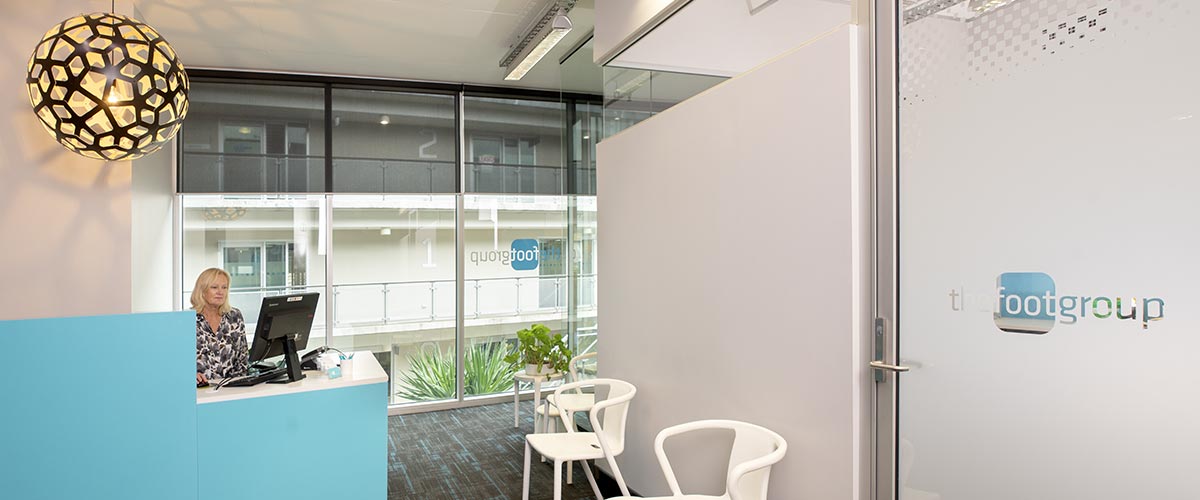Knee pain

Do you have pain around and under your knee cap?
Every day our knees move repetitively, bear weight and absorb impact. So it’s not surprising that our knees experience a variety of painful conditions, all with their own causes and treatments. Knee pain can be caused by a variety of factors including bursitis, tendinitis, arthritis, tears in the ligaments, or menisci (osteoarthritis of the joint) or infection – and very commonly by a condition known as runner’s knee.
How does a podiatrist identify the source of knee pain?
Correctly identifying your particular kind of knee pain is vital to effective treatment. We use a thorough biomechanical assessment to identify whether structural issues such as poor foot posture are the cause of your knee pain.
These common sources of knee pain require podiatric diagnosis and treatment:
This syndrome is often a knee alignment problem stemming from poor foot posture. As the foot moves on the ground it sets up a chain reaction of movements throughout the body. If the foot is not aligned properly this can cause issues further up the lower limb, magnifying as the movement or rotation travels up to the knee.
Patella tendinopathy is an injury of the patella tendon, which attaches the bottom of your knee cap (patella) to the top of your shin bone (tibia).
It is an overuse injury caused by repetitive movements such as jumping, landing and/or changing direction when running. Activities or sports that involve these movements such as basketball, volleyball, netball, track and field events, rugby and soccer can place this sort of strain on the knee.
The pain usually begins as tenderness at the bottom of the knee (between the knee cap and the shin bone). There may be thickening of the tendon but usually minimal soft tissue swelling. Because it doesn’t inhibit usual performance, the pain is often ignored, but it is important to seek treatment early as the injury can progress from pain just after sports/activity to pain in everyday activity.
Treatments for patella tendinopathy may include:
- Reduce load on the knee – stop or modify the amount and intensity of sport
- Orthotics to correct biomechanics (excess pronation)
- Physiotherapy to strengthen the muscles, especially the quadriceps
- Knee surgery if these treatments fail or they are brought to a podiatrist’s attention too late.
Iliotibial Band (ITB) friction syndrome is the painful inflammation of the outside (lateral) area of the knee. It is the result of friction or impingement between the end of the thigh bone (femur) near the knee and the iliotibial band. Pain is usually felt along the outside of the knee and is especially aggravated by downhill running.
Knock knees (genu valgum) as well as flat feet (excessive foot pronation) are commonly related biomechanical traits which may be exacerbating the issue.
Treatments for ITB friction syndrome may include:
- Stop activity
- Apply ice to the knee, 20 minutes on, 20 minutes off, then repeat once
- Strengthen the hip muscle with physiotherapy
- Correct foot biomechanics with orthotics
- Stretching
- Massage
- Foam roller.
Osteoarthritis, also referred as wear and tear arthritis, is the breakdown of joint cartilage, leading to pain. This cartilage acts as a cushioning for the joints so the more it breaks down, the more pain and deformity occurs. Osteoarthritis is the leading cause of pain and disability among the elderly. It is most common in higher-weight bearing joints such as the knees.
At The Foot Group we assess the alignment, pressure and gait of our patients with osteoarthritis, as joint malalignment can cause abnormal pressure distribution underfoot, leading to poor shock absorption and more pain associated with osteoarthritis at the knees.
Treatments for osteoarthritis may include:
- Orthotics to correct malalignment and improve foot mechanics at the feet while also doing the best job possible to improve shock absorption and weight distribution at the foot level, lowering the load at the knees.
- Losing weight with a nutritionist and/or personal trainer
- Physiotherapy to improve quadriceps strength
How do podiatrists treat knee pain?
- Orthotic therapy is a most effective treatment for this type of condition. Our specially customised foot orthotics enhance the alignment of the foot and underlying biomechanical cause of the condition and encourage a more efficient knee alignment during walking and running.
- Rehabilitation for knee surgeries such as ACL/PCL repair, meniscus repair and arthroscopies will more often than not require supportive prescription-made orthotics to help stabilise the foot, ankle and knee. These devices are used to manage recovery better but also can still be worn once the knee is good.
- Appropriate footwear is important in preventing runner’s knee pain. Our podiatrists, who focus on biomechanics, are experts in shoe recommendation, and can assist you with an appropriate and comfortable footwear selection.
We can refer you to other allied health professionals
When dealing with knee injury or pain it is always important to make sure you are getting the best treatment possible. Gold standards for knee injury treatment require a multidisciplinary approach. At The Foot Group we understand this. Our strong relationships with other local health professionals such as physiotherapists, general practitioners, osteopaths, chiropractors and personal trainers ensure our patients have the best chance of recovery.



